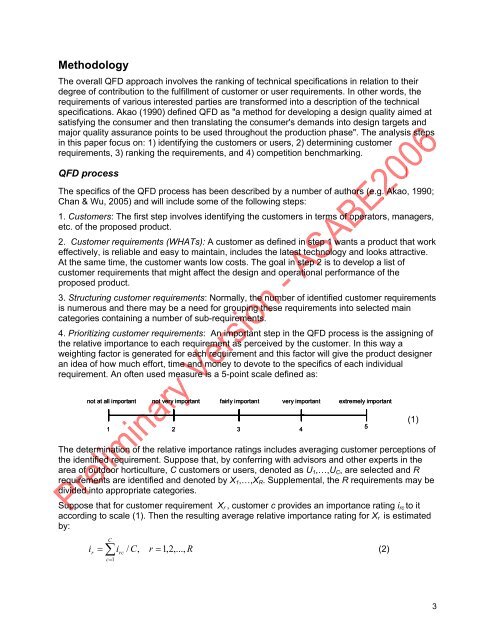Application of Quality Function Deployment (QFD) - HortiBot
Application of Quality Function Deployment (QFD) - HortiBot
Application of Quality Function Deployment (QFD) - HortiBot
You also want an ePaper? Increase the reach of your titles
YUMPU automatically turns print PDFs into web optimized ePapers that Google loves.
Methodology<br />
The overall <strong>QFD</strong> approach involves the ranking <strong>of</strong> technical specifications in relation to their<br />
degree <strong>of</strong> contribution to the fulfillment <strong>of</strong> customer or user requirements. In other words, the<br />
requirements <strong>of</strong> various interested parties are transformed into a description <strong>of</strong> the technical<br />
specifications. Akao (1990) defined <strong>QFD</strong> as "a method for developing a design quality aimed at<br />
satisfying the consumer and then translating the consumer's demands into design targets and<br />
major quality assurance points to be used throughout the production phase". The analysis steps<br />
in this paper focus on: 1) identifying the customers or users, 2) determining customer<br />
requirements, 3) ranking the requirements, and 4) competition benchmarking.<br />
<strong>QFD</strong> process<br />
The specifics <strong>of</strong> the <strong>QFD</strong> process has been described by a number <strong>of</strong> authors (e.g. Akao, 1990;<br />
Chan & Wu, 2005) and will include some <strong>of</strong> the following steps:<br />
1. Customers: The first step involves identifying the customers in terms <strong>of</strong> operators, managers,<br />
etc. <strong>of</strong> the proposed product.<br />
2. Customer requirements (WHATs): A customer as defined in step 1 wants a product that work<br />
effectively, is reliable and easy to maintain, includes the latest technology and looks attractive.<br />
At the same time, the customer wants low costs. The goal in step 2 is to develop a list <strong>of</strong><br />
customer requirements that might affect the design and operational performance <strong>of</strong> the<br />
proposed product.<br />
3. Structuring customer requirements: Normally, the number <strong>of</strong> identified customer requirements<br />
is numerous and there may be a need for grouping these requirements into selected main<br />
categories containing a number <strong>of</strong> sub-requirements.<br />
4. Prioritizing customer requirements: An important step in the <strong>QFD</strong> process is the assigning <strong>of</strong><br />
the relative importance to each requirement as perceived by the customer. In this way a<br />
weighting factor is generated for each requirement and this factor will give the product designer<br />
an idea <strong>of</strong> how much effort, time and money to devote to the specifics <strong>of</strong> each individual<br />
requirement. An <strong>of</strong>ten used measure is a 5-point scale defined as:<br />
not at all important not very important fairly important very important extremely important<br />
1 2 3 4<br />
The determination <strong>of</strong> the relative importance ratings includes averaging customer perceptions <strong>of</strong><br />
the identified requirement. Suppose that, by conferring with advisors and other experts in the<br />
area <strong>of</strong> outdoor horticulture, C customers or users, denoted as U1,…,UC, are selected and R<br />
requirements are identified and denoted by X1,…,XR. Supplemental, the R requirements may be<br />
divided into appropriate categories.<br />
Suppose that for customer requirement Xr , customer c provides an importance rating irc to it<br />
according to scale (1). Then the resulting average relative importance rating for Xr is estimated<br />
by:<br />
C<br />
r = ∑ irc<br />
c=<br />
1<br />
i<br />
/ C,<br />
r = 1,<br />
2,...,<br />
R<br />
5<br />
(2)<br />
(1)<br />
3



